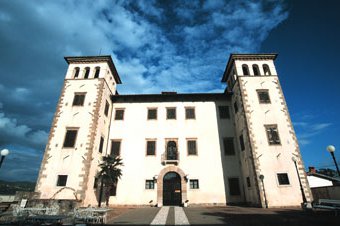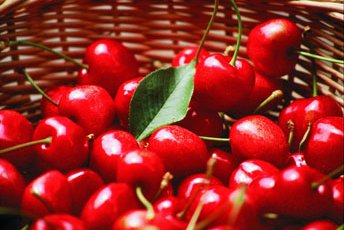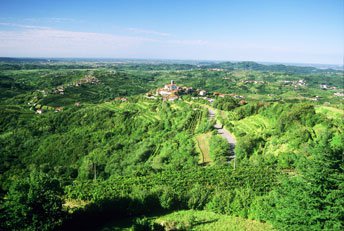Goriška Brda
At the foremost west of Slovenia lies a small land called Brda. Wonderfull country split in two by the border between the two countries. It lies between river Soča at southeast and river Idria at the northwest. From Korada to Sabotin the area fanlike lowers until the undulating hills fall into Furlan lowland. Brda hills are specific in that they are all covered with wine yards and fruit trees. On every hill we find a merged village with a small church.
Brda are typically made of layers of marl, sandstone and clay. Fertile land, good climate, long tradition and brave hands of peasants from Brda have turned this place into haven on earth. On gently slopping but also steep grounds on the sun, beautiful terraces are covered with wine yards, fruit trees and already rare remains of old “brajde”. All these give to this land a special character in all seasons of the year. First guest on all Slovene marketplaces are exactly cherries from Brda. Here cherries have a special role. To the peasant they represent the first money of the year and once whole families depended on them. These cherries were known also on the Vienna court. In summer peaches become the main fruit (also in absolute terms) in Brda. Apart from peaches, apricots, pears, apples, figs, plums and kaki also grow in this region. Slowly olive trees return. Once there were many but a frost at the end of nineteen twenties killed most of them. Wine yards were here from the old times. Today there are 1800 ha of them. Most well known white wines are: Rebula, Chardonay and Sauvignon. Amongst red ones, on the other hand, are Merlot and Cabernet Sauvignon. Big breakthrough in wine production happened after the second world war with the creation of the modern wine cellar at Dobrovo. In the last years private individual wine producers are more and more prominent.
Brda are not just land of fruit and wine but they hide many cultural highlights. The whole country can be seen in its entirety from the 23m high view tower in Gonjače. This is also the central point of the land. Here we can see Furlan country all up to the sea, Julian and Kamnik alps, Dolomites, Trnovo Woodlands, Vipava valley and Kras. Under the tower there is a monument to the victims of the second world war. At the administrative center of Brda, Dobrovo, we find a renaissance castle from 17th century which came almost intact from way back. Today many cultural events take place here. In the wine cellar there is a big collection of wines from this region. This is not the only castle in Brda. At Vipolže we have two more, the most important one dating from 11th century. On almost every hill there is, in the middle of a merged village, a small church. Church towers are like small fortresses. They hide many treasures. In the church of Holly Cross at Kojsko there is an almost entirely preserved altar from the year 1515. On the other side of the Brda at Golo Brdo we have in the church of Mary on the lake preserved an altar of Sad Holly Mary. One of the most beautiful villages is Šmartno, a cultural monument by itself. The village preserved signs of an old, fortified, Mediterranean settlement. It has been built on the grounds of an old roman fortification. The walls with the towers were the protection against Turk invaders in first half of 16th century.
This are Brda, a unique mosaic of a beautiful landscape, architectural marvels and good working people.



